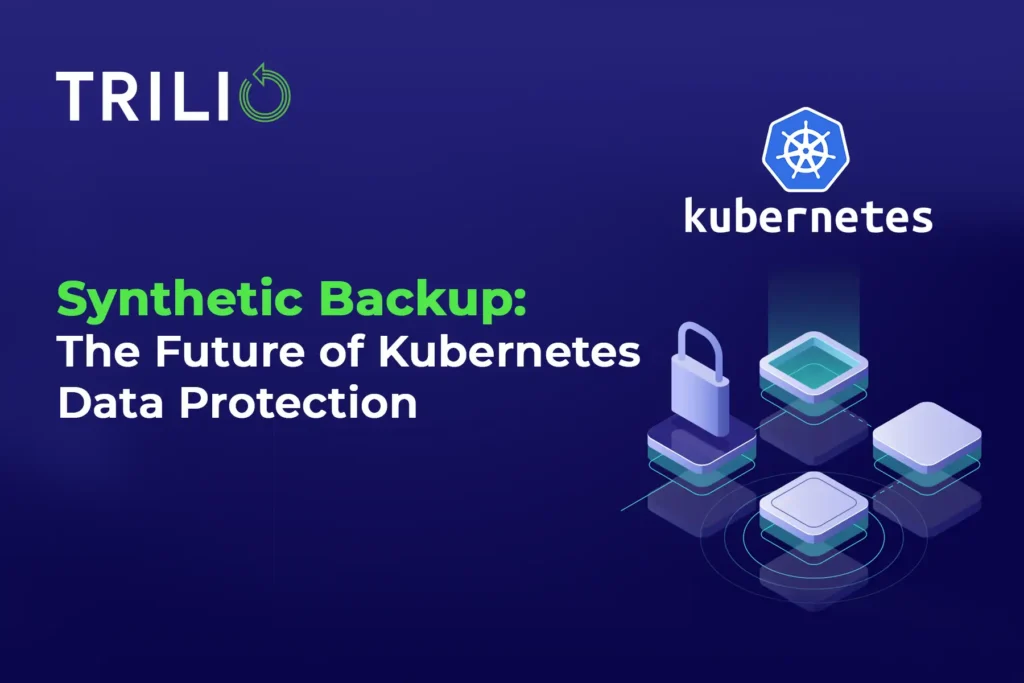Traditional backup methods, though useful, often struggle to keep up with the complexities and constant changes in Kubernetes environments. This is where synthetic backup comes in—a revolutionary approach that significantly improves data protection.
In this article, we explore what synthetic backup is and why it’s a better option than traditional methods. We discuss the specific benefits it offers for Kubernetes applications, including real-world examples and technical insights. Whether you’re an IT specialist, DevOps engineer, or executive, learning about and using synthetic backups can greatly enhance your data protection strategies.
Understanding Synthetic Backup
What Is Synthetic Backup?
Synthetic backup, also known as synthetic full backup, is a modern data protection technique that consolidates incremental backups into a full backup without having to copy all the data again. Instead of creating a new full backup from scratch, synthetic backup uses the last full backup and subsequent incremental backups to synthesize a new full backup. This process reduces the load on the production environment and speeds up the backup process.
How Does It Work?
With traditional backup methods, a full backup captures the entire dataset at a specific point in time, while incremental backups only capture the changes since the last backup. Over time, managing these incremental backups alongside full backups can become cumbersome and resource-intensive. Synthetic backup avoids this situation by creating a new full backup using existing data, thus avoiding the need to repeatedly copy unchanged data.
For instance, suppose that you have a full backup from Sunday and incremental backups from Monday to Saturday. With synthetic backup, you don’t need to perform another full backup on the following Sunday. Instead, the system combines the full backup from the previous Sunday with the incremental backups from during the week to create a new full backup, effectively synthesizing a current full backup.
Benefits of Synthetic Backup
Synthetic backup provides a number of important benefits:
- Efficiency and Speed: Since they reduce the need to duplicate data, synthetic backups are faster and more efficient than traditional full backups. This is particularly beneficial for large datasets and dynamic environments like Kubernetes.
- Reduced Network Load: Synthetic backups minimize network traffic by using existing backup data, which is crucial for environments with limited bandwidth or high data volumes.
- Lower Storage Costs: Synthetic backups use incremental data, which means that they require less storage space than performing frequent full backups, leading to cost savings on storage.
- Enhanced Data Protection: By maintaining up-to-date full backups synthesized from incremental backups, synthetic backup ensures that data protection is both comprehensive and current.
Synthetic Backup vs. Traditional Methods
Traditional backup methods include full, incremental, and differential backups. While each has its merits, they also have limitations. Full backups are comprehensive but time-consuming and storage-intensive. Incremental backups are efficient but require a longer restoration process, as multiple incremental backups need to be applied. Differential backups, which capture changes since the last full backup, strike a balance but can still become large over time.
Synthetic backup offers the best of both worlds: the completeness of full backups combined with the efficiency of incremental backups. This approach makes it an ideal solution for modern IT environments, especially those utilizing Kubernetes, where agility and efficiency are paramount.
Synthetic Backup in Kubernetes: A Game Changer
Challenges of Backing up Kubernetes Applications
Kubernetes has become the de facto standard for container orchestration, enabling rapid deployment, scaling, and management of containerized applications. However, its dynamic nature presents unique challenges for data protection:
- Dynamic Environments: Kubernetes clusters are highly dynamic, with applications constantly scaling up and down, making it difficult to maintain consistent backups.
- Complexity: The distributed architecture of Kubernetes applications, with multiple pods and services, complicates the backup process.
- Stateful Applications: While Kubernetes is excellent for stateless applications, managing stateful applications like databases and ensuring consistent backups of their data adds another layer of complexity.
How Synthetic Backups Address These Challenges
Synthetic backups offer several advantages that make them particularly well-suited for Kubernetes environments:
- Scalability: As Kubernetes applications scale, synthetic backups can efficiently handle the increased data volumes without significantly impacting performance.
- Consistency: By synthesizing backups from incremental snapshots, synthetic backups ensure that the entire state of the application, including all pods and services, is consistently protected.
- Reduced Overhead: Traditional backup methods can be resource-intensive, straining the Kubernetes cluster. Synthetic backups leverage incremental data to minimize this overhead, ensuring smoother operation.
- Simplified Management: Managing backups in a Kubernetes environment can be complex. Synthetic backups simplify this process by reducing the frequency of full backups, making it easier to manage and schedule backup operations.
Real-World Applications and Use Cases
Synthetic backups have practical applications that offer significant benefits in a variety of real-world Kubernetes environments:
- DevOps Pipelines: In continuous integration and continuous deployment (CI/CD) pipelines, synthetic backups provide a reliable way to ensure that application states are consistently backed up and can be restored quickly, minimizing downtime and facilitating rapid development cycles.
- Disaster Recovery: Synthetic backups provide a robust disaster recovery solution for businesses relying on Kubernetes for critical applications. By maintaining up-to-date synthetic full backups, organizations can quickly recover from data loss incidents.
- Compliance: Many industries have stringent compliance requirements for data protection. Synthetic backups help meet these requirements by ensuring that complete, consistent backups are readily available without the need for excessive storage or network resources.
Technical Insights and Benefits
From a technical perspective, synthetic backups offer several key benefits:
- Optimized Storage: By reducing the need for frequent full backups, synthetic backups optimize storage usage, making it more cost-effective.
- Faster Restores: Synthetic full backups allow for faster restore times because they provide a single, consolidated backup from which to restore rather than piecing together multiple incremental backups.
- Automation Friendliness: Kubernetes environments thrive on automation. Synthetic backup processes can be easily integrated into existing automation frameworks, ensuring seamless and reliable data protection.

Automated Kubernetes Data Protection & Intelligent Recovery
Perform secure application-centric backups of containers, VMs, helm & operators
Use pre-staged snapshots to instantly test, transform, and restore during recovery
Scale with fully automated policy-driven backup-and-restore workflows
Maximizing Data Protection Strategies
Best Practices for Implementing Synthetic Backups
Implementing synthetic backups effectively requires adherence to certain best practices to maximize their benefits. Here are some key strategies to consider:
- Perform Regular Incremental Backups: Ensure that incremental backups are performed regularly to keep data up to date. Frequent incremental backups minimize data loss and make the synthetic backup process more efficient.
- Automate Backup Processes: Leverage automation tools to schedule and manage backups. Automation reduces the risk of human error and ensures that backups are performed consistently without manual intervention.
- Monitor and Audit Backups: Regularly monitor backup operations and audit backups to verify their integrity. This practice helps with identifying and resolving issues promptly, ensuring that your backup data is always reliable.
- Test Restores: Periodically perform test restores to verify that backups can be successfully restored. Testing helps you identify potential issues so you can recover data quickly in the event of a disaster.
- Policy-Driven Management: Implement policies to define backup schedules, retention periods, and recovery point objectives (RPOs). Policy-driven management ensures that backups align with organizational goals and compliance requirements.
Combining Synthetic Backups with Other Data Protection Strategies
While synthetic backups are highly effective, combining them with other data protection strategies can further enhance your overall backup and recovery capabilities:
- Snapshot-Based Backups: Use snapshot-based backups to capture the state of your applications at specific points in time. Snapshots provide a quick and efficient way to create point-in-time copies of your data, which can be integrated with synthetic backups for comprehensive protection.
- Disaster Recovery Planning: Develop a comprehensive disaster recovery plan that includes synthetic backups as a key component. Ensure that your plan covers various disaster scenarios and outlines the steps for restoring data and applications.
- Multi-Cloud and Hybrid Cloud Support: Implement data protection strategies that support multi-cloud and hybrid cloud environments. This approach ensures that your data is protected regardless of where it resides, providing greater flexibility and resilience.
- Data Encryption: Encrypt your backup data to protect it from unauthorized access. Data encryption ensures that your backup data remains secure both in transit and at rest.
Future Trends and Innovations in Backup Technology
The field of data protection is constantly evolving, with new trends and innovations emerging that promise to enhance backup and recovery capabilities:
- AI/ML: Artificial intelligence and machine learning are being increasingly integrated into backup solutions to optimize backup processes, predict potential issues, and automate recovery operations.
- Immutable Backups: Immutable backups are gaining traction as a way to protect data from ransomware attacks. Immutable backups provide an additional layer of security by ensuring that backup data cannot be altered or deleted.
- Edge Computing: As edge computing becomes more prevalent, backup solutions are being developed to support data protection at the edge. This approach ensures that data generated at the edge is protected and can be seamlessly integrated with centralized backups.
- Data Reduction Technologies: Advanced data reduction technologies, such as deduplication and compression, are being used to minimize the storage footprint of backups. These technologies help reduce costs and improve backup efficiency.
Conclusion: Embracing the Future of Data Protection
Having a robust and efficient data protection strategy is essential. Synthetic backup technology offers a powerful solution, especially for Kubernetes environments, by combining incremental and full backups into a streamlined, effective process. This approach reduces infrastructure load and ensures faster, more reliable data recovery. Implementing best practices—such as regular incremental backups, automation, and comprehensive disaster recovery planning—maximizes the benefits of synthetic backups. Combining synthetic backups with other data protection strategies, like snapshot-based backups and encryption, further enhances your backup and recovery capabilities.
Adopting advanced solutions like those offered by Trilio can significantly enhance your data protection efforts. Trilio’s seamless integration, automated processes, and optimized performance make it an ideal choice for IT specialists, DevOps teams, and executives. Embrace synthetic backups to ensure that your Kubernetes applications are secure, resilient, and ready for any challenge. For more information and to speak to an expert, contact us today to learn how Trilio can help you optimize your data protection strategy.
Learn about a lead telecom firm solved K8s backup and recovery with Trilio
FAQs
What is the main advantage of using synthetic backup over traditional backup methods?
The main advantages are efficiency and resource optimization. Traditional backups, especially full backups, require copying all data every time a backup is performed, which can be time-consuming and storage-intensive. Synthetic backups, on the other hand, create a full backup by consolidating incremental backups. This means that after the initial full backup, only the changes since the last backup are recorded in subsequent incremental backups. The synthetic backup process then merges these incremental backups with the initial full backup to produce an up-to-date full backup. This significantly reduces the amount of data that needs to be copied and stored, leading to faster backup times and lower storage costs.
How does synthetic backup improve disaster recovery times?
Synthetic backup improves disaster recovery times by providing a single, consolidated full backup that is readily available for restoration. In the event of a data loss incident, having a synthetic full backup means that there is no need to sequentially restore multiple incremental backups to get the system back to its last known good state. Instead, the synthetic backup contains all the necessary data in one place, allowing for a much quicker recovery process. This is particularly crucial in environments like Kubernetes, where minimizing downtime is essential for maintaining application availability and performance. By reducing the complexity and time required for data restoration, synthetic backups enhance overall disaster recovery readiness and effectiveness.
Can synthetic backup be used in multi-cloud environments?
Yes. Multi-cloud strategies involve using multiple cloud service providers to avoid vendor lock-in, increase resilience, and optimize performance. Synthetic backups are well-suited for this approach because they can operate across different cloud platforms, ensuring consistent and efficient data protection regardless of where the data resides. By integrating synthetic backups into a multi-cloud strategy, organizations can maintain a unified backup and recovery process, simplifying management and ensuring that all cloud-based data is equally protected. This flexibility makes synthetic backups an ideal choice for organizations with complex, distributed IT infrastructures.
What impact does synthetic backup have on network bandwidth?
Synthetic backup minimizes the amount of data transferred during the backup process. Traditional full backups require transferring the entire dataset, which can consume significant network resources, especially for large volumes of data. With synthetic backup, only the incremental changes since the last backup need to be transferred over the network. This incremental approach drastically reduces the data transfer requirements, leading to lower bandwidth consumption. This is particularly beneficial in environments with limited network capacity or where bandwidth is a critical resource. By reducing network load, synthetic backups help maintain overall network performance and ensure that backup operations do not interfere with regular business activities.




